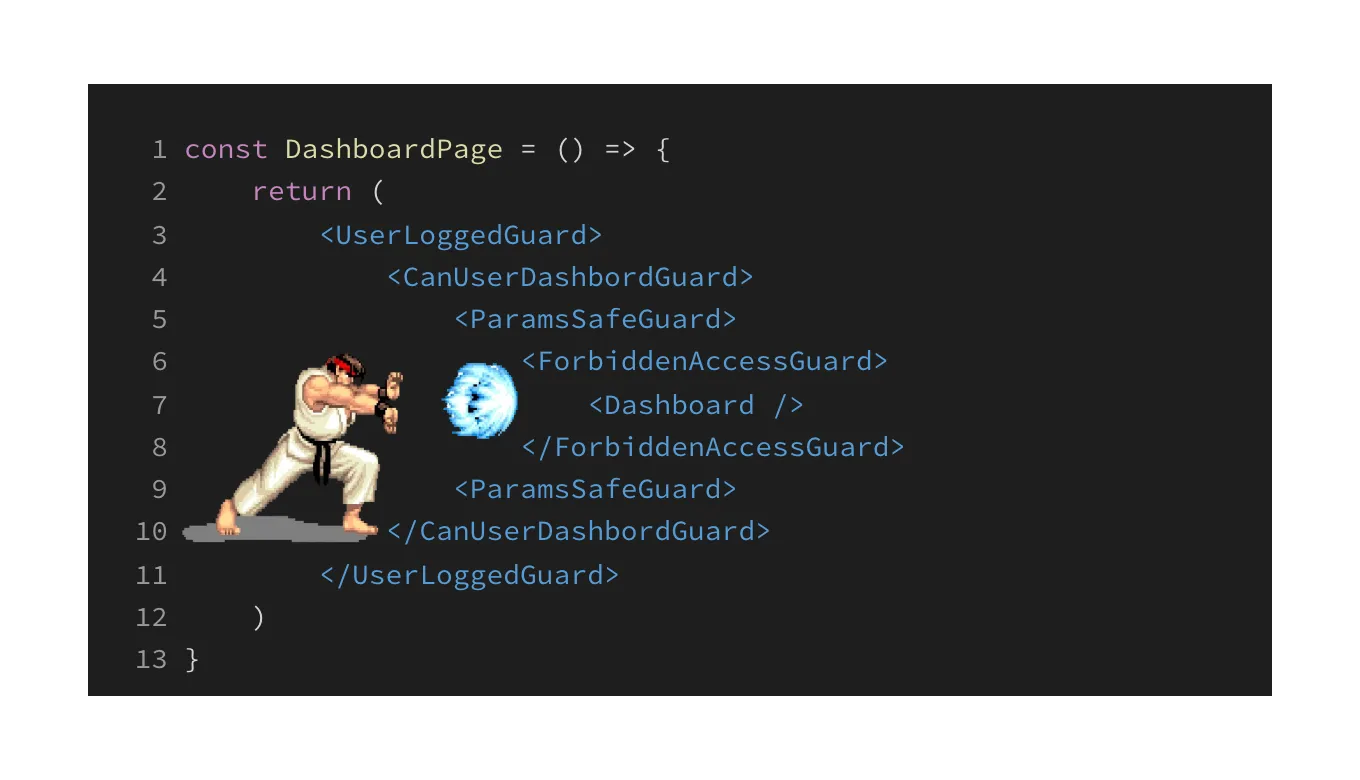The guardian of Server Component in Next.js
ℹ️ 本文发布于请注意文中内容的时效性。
在服务端开发中,鉴权、认证、校验等业务规则检查是不可或缺的,但当这些代码与 Server Component 结合时,我们应该如何更优雅地处理呢?🤔
通常最简单的处理方式就是通过增加 IF/ELSE 控制流来完成业务规则检查。
const DashboardPage = async () => {
const isUserLoggedIn = await fetchUser()
if (!isUserLoggedIn) {
redirect("/login")
}
const canUseDashboard = await queryFeatureFlag("dashboard")
if (!canUseDashboard) {
redirect("/access-denied")
}
return <Dashboard />
}
但当业务规则检查越来越多的时候,更恰当的方式是使用 Container Pattern ,通过分离关注点的方式,增强代码的可维护性。
const UserLoggedGuard = async ({ children }) => {
const isUserLoggedIn = await fetchUser()
if (!isUserLoggedIn) {
redirect("/login")
}
return children
}
const CanUserDashbordGuard = async ({ children }) => {
const canUseDashboard = await queryFeatureFlag("dashboard")
if (!canUseDashboard) {
redirect("/access-denied")
}
return children
}
const DashboardPage = async () => {
return (
<UserLoggedGuard>
<CanUserDashbordGuard>
<Dashboard />
</CanUserDashbordGuard>
</UserLoggedGuard>
)
}
但带来的另一个问题就是,一旦 Guard 组件过多,对业务组件 JSX 的侵入就变得很严重。
const DashboardPage = () => {
return (
<UserLoggedGuard>
<CanUserDashbordGuard>
<ParamsSafeGuard>
<ForbiddenAccessGuard>
<Dashboard />
</ForbiddenAccessGuard>
<ParamsSafeGuard>
</CanUserDashbordGuard>
</UserLoggedGuard>
)
}
看到上面的代码,你脑海里是否又响起了熟悉的“Hadoken!” 🫨
 此时为了避免 Guard 组件对业务组件的侵入,在设计上可以考虑根据 Server Component 的特性把这些 Guard 抽离出来,变成这样:
此时为了避免 Guard 组件对业务组件的侵入,在设计上可以考虑根据 Server Component 的特性把这些 Guard 抽离出来,变成这样:
const DashboardPage = () => {
return <Dashboard />
}
export default composeGuard(UserLoggedGuard, CanUserDashbordGuard, ParamsSafeGuard, ForbiddenAccessGuard, DashboardPage)
现在看起来 Dashboard 的业务代码是不是更干净了?Guard 组件也更集中,方便统一查看检查规则。
那 composeGuard 要如何实现呢?在 Server Component 体系下,每个 Guard 都是一个独立的 Server Component,也是一个个的异步函数。想要实现这个逻辑也非常简单,就是把一堆异步函数放在一起,按顺序执行。我们可以按照这样的思路来实现:
首先在 TS 中定义出来我们需要的类型:
export interface NextSCProps<
Params extends NodeJS.Dict<string> = NodeJS.Dict<string>,
SearchParams extends ParsedUrlQuery = ParsedUrlQuery
> {
params: Params
searchParams: SearchParams
}
export interface NextSC<
Params extends NodeJS.Dict<string> = NodeJS.Dict<string>,
SearchParams extends ParsedUrlQuery = ParsedUrlQuery
> {
(props: NextSCProps<Params, SearchParams>): Promise<
React.ComponentType<React.PropsWithChildren<NextSCProps<Params, SearchParams>>>
>
}
之后再来实现 compose 函数:
const composeGuard = (...guards: NextSC[]): NextSC => {
return async (props: NextSCProps) => {
for (const currentRSC of guards) {
return await currentRSC(props)
}
}
}
💂 composeGuard 现在的逻辑非常简单,就是生成一个新的 ServerComponent,然后在这个新生成的 Server Component 中逐个运行给定的 guard。
但是 Bug 🐛 也非常明显,因为我们直接 return 了第一个 guard,导致现在 composeGuard 的结果只会渲染出第一个 Component 💩。但我们期望的是 guard 在业务规则检查通过之后就运行后面的 Guard,直到所有的 guard 都运行完为止。这里我们可以参考 Next.js 中 notFound 和 redirect 的 API 设计,通过抛异常来明确程序行为。
这里我们先定义出 NextGuardError
class NextGuardError extends Error {}
export function nextGuard(): never {
throw new NextGuardError("go to next guard")
}
export function isNextGuardError(error: any): error is NextGuardError {
return error instanceof NextGuardError
}
之后再补全 composeGuard 的代码逻辑:
const composeGuard = (...guards: NextSC[]): NextSC => {
return async (props: NextSCProps) => {
for (const guard of guards) {
try {
return await guard(props)
} catch (error) {
if (isNextGuardError(error)) {
continue
}
throw error
}
}
return null // 这里也可以选择继续抛出异常
}
}
至此,我们的 composeGuard 基本就已经写完了,使用起来也很简单。以CanUserDashbordGuard 为例:
const CanUserDashbordGuard = async ({ children }) => {
const canUseDashboard = await queryFeatureFlag("dashboard")
if (!canUseDashboard) {
redirect("/access-denied")
}
nextGuard() // 逻辑检查通过之后,执行后续 guard
}
在业务逻辑检查中,如果不符合条件可以直接渲染 UI 告知用户,也可以使用 notFound 或者 redirect 跳转到其他的页面中。但逻辑检查通过之后,可以使用 nextGuard 继续执行后续的 guard。
回过头来再看一下之前的代码示例:
const DashboardPage = () => {
return <Dashboard />
}
export default composeGuard(UserLoggedGuard, CanUserDashbordGuard, ParamsSafeGuard, ForbiddenAccessGuard, DashboardPage)
现在用户打开 Dashboard 页面时,会顺序经过 UserLoggedGuard、CanUserDashbordGuard、ParamsSafeGuard 和 ForbiddenAccessGuard。 但这些 guard 全部运行结束之后就会进入到 DashboardPage 执行核心的业务逻辑。这样,通过 Server Component 守卫,我们能够更清晰、更优雅地组织和处理业务逻辑,使代码更易读、易维护。